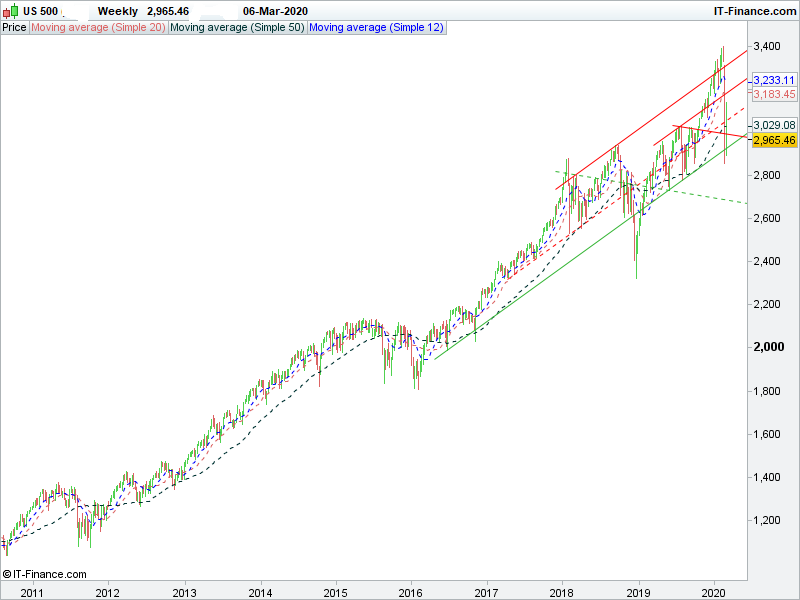The 2009 to 2020 bull market has conditioned investors to buy when the market falls. But Covid-19 has caused acute uncertainty. Will “buy on dips” work this time?
Wall Street and other stock markets rallied late last Friday, but revivals were weak. Technical analysts contend that key support for the S&P 500 index is around 2850 This is the low point after the February mini-crash.
London’s FTSE 100 index has sunk well below its February nadir. Indeed, the index is back to the depressed levels of late December 2018. German, French, Italian and Japanese markets have experienced similar plunges. Putting it in stark brutal language, entire gains of these markets in 2019 have been wiped out.
Bargain hunters should be extra careful
Growing numbers of UK and other shares are now trading with low price-earnings ratios and above-average dividend yields. These historic values will no doubt attract bargain hunters. But the keyword in the current Covid-19 crisis is “historic”. Profits of key industries ranging from energy and mining to travel, transport, entertainment and retailing are likely to fall. Yes, the markets could rally if there’s news of a remedy, vaccine or successful containment. But poor profits and bad news from indebted, highly geared companies could send the market lower again.

Despite relative over valuation Wall Street still outperforms global markets
In contrast, the FAANGs–Facebook, Apple,Amazon, Netflix and Google–plus Microsoft and other tech stocks have kept the indices well above the December 2018 depression. NASDAQ is 46% higher than those lows and its leading stocks have kept the S&P 500 some 28% above the 2018 nadir. The Dow Jones index is also some 20% higher.
Goldman Sachs reported that several US companies were buying their own shares and several fund managers said that they were seeking good value cash rich stocks.

Relatively cheap does not prevent stocks from becoming cheaper
Asian share markets have been hit badly. CAPE (cyclically adjusted price-to-earnings) analysis shows that China, South Korea and Singapore are offering relatively good value. But relative cheap valuations aren’t a guarantee against further declines.

Professor Shiller, winner of the Nobel Prize for Economics, said that the CAPE ratio is a useful guideline to determine whether a market is under or overvalued.
CAPE is a valuation guide, but can’t time markets
Cape is calculated as a ratio of the current market price of an individual share or stock index over the average inflation-adjusted earnings of the 10 preceding years. Norbert Keimling, the head of capital market research at StarCapital in Germany, values global markets on this basis.
As can be seen from the table Mr Keimling calculates that Russia, South Korea, Singapore, Hong Kong, Spain, China and the UK offer reasonable value.
In contrast, the most expensive equity global markets, according to Cape analysis, are the US, followed by New Zealand, Switzerland, the Netherlands, France, India and Australia.
For example, the US’ CAPE at the end of February 2020 was as high as 27.9 and average price earnings ratio 20.9 at the end of January. Despite its 13% decline from its all time peak, the S&P 500 can hardly be described as a bargain.
Passive investment causes problems in bear markets
Good shares are falling with the bad because passive investment has become fashionable in recent years. Instead of picking individual stocks, growing numbers of investors are choosing index-linked investments.
Deborah Fuhr, who heads the consulting firm ETFGI, estimates that exchange traded funds (ETFs) and exchange traded products (ETPs) soared from US$319 billion in 2004 to US$6.37 trillion at the end of January 2020.
In the three decades since inception, the numbers of these products have grown to just under 8,000.
ETFs help boost bull markets as they have portfolios of shares that match market or sector indices. The problem arises when markets begin to fall. Holders begin selling their ETFs and the fund managers have to sell the individual shares. The good shares thus fall with the bad.
Central banks are ready to provide liquidity to the markets
But interest rate cuts will not counter supply dislocations and logjams and lower spending of fearful consumers.
Since Wall Street sets the tone for global equities, and the undervalued shares have slid with the overvalued ones, veteran investors such as Warren Buffett are advising investors to “proceed with caution”.
© Neil Behrmann
For entertainment and investment ideas, take a look at Neil’s books. They can easily be found via his author page on Amazon https://www.amazon.co.uk/Neil-Behrmann/e/B005HA9E3M
Neil’s financial thrillers Trader Jack- The Story of Jack Miner and its sequel Jack of Diamonds have had excellent reviews which include comments on the in-depth research into gold and gold share trading, diamond markets and financial bubbles and crashes. Children 8 to 12 have also enjoyed the anti-war fantasy, Butterfly Battle- The Story of the Great Insect War. It had exceptional reviews.
